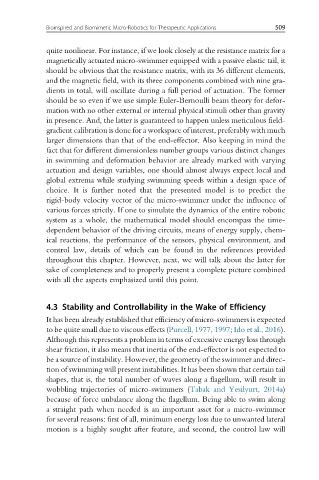Page 515 - Handbook of Biomechatronics
P. 515
Bioinspired and Biomimetic Micro-Robotics for Therapeutic Applications 509
quite nonlinear. For instance, if we look closely at the resistance matrix for a
magnetically actuated micro-swimmer equipped with a passive elastic tail, it
should be obvious that the resistance matrix, with its 36 different elements,
and the magnetic field, with its three components combined with nine gra-
dients in total, will oscillate during a full period of actuation. The former
should be so even if we use simple Euler-Bernoulli beam theory for defor-
mation with no other external or internal physical stimuli other than gravity
in presence. And, the latter is guaranteed to happen unless meticulous field-
gradient calibration is done for a workspace of interest, preferably with much
larger dimensions than that of the end-effector. Also keeping in mind the
fact that for different dimensionless number groups various distinct changes
in swimming and deformation behavior are already marked with varying
actuation and design variables, one should almost always expect local and
global extrema while studying swimming speeds within a design space of
choice. It is further noted that the presented model is to predict the
rigid-body velocity vector of the micro-swimmer under the influence of
various forces strictly. If one to simulate the dynamics of the entire robotic
system as a whole, the mathematical model should encompass the time-
dependent behavior of the driving circuits, means of energy supply, chem-
ical reactions, the performance of the sensors, physical environment, and
control law, details of which can be found in the references provided
throughout this chapter. However, next, we will talk about the latter for
sake of completeness and to properly present a complete picture combined
with all the aspects emphasized until this point.
4.3 Stability and Controllability in the Wake of Efficiency
It has been already established that efficiency of micro-swimmers is expected
to be quite small due to viscous effects (Purcell, 1977, 1997; Ido et al., 2016).
Although this represents a problem in terms of excessive energy loss through
shear friction, it also means that inertia of the end-effector is not expected to
be a source of instability. However, the geometry of the swimmer and direc-
tion of swimming will present instabilities. It has been shown that certain tail
shapes, that is, the total number of waves along a flagellum, will result in
wobbling trajectories of micro-swimmers (Tabak and Yesilyurt, 2014a)
because of force unbalance along the flagellum. Being able to swim along
a straight path when needed is an important asset for a micro-swimmer
for several reasons: first of all, minimum energy loss due to unwanted lateral
motion is a highly sought after feature, and second, the control law will

